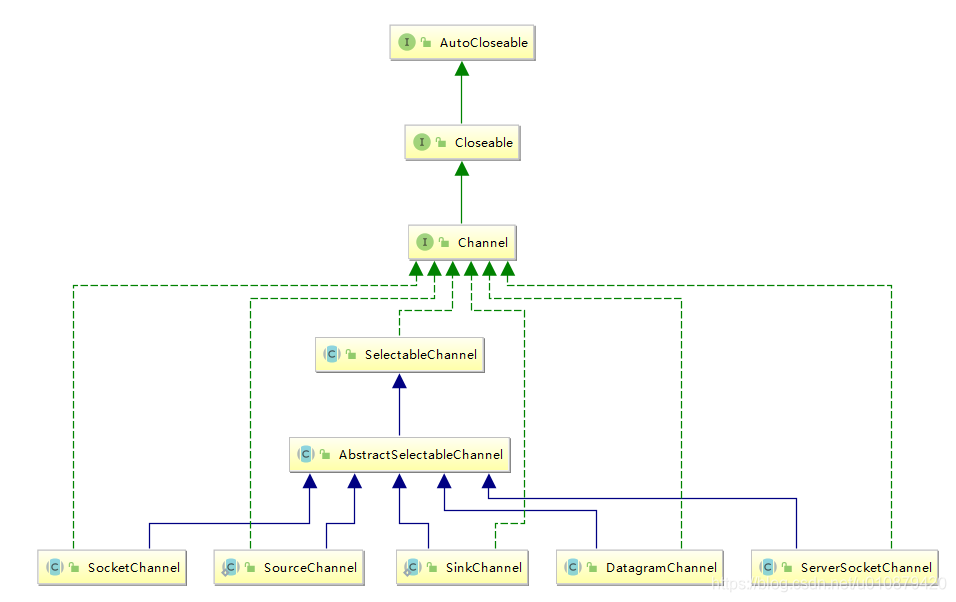NIO
1 JAVA NIO简介
NIO与原来的IO有同样的作用和目的,但是使用方式完全不同,NIO支持面向缓存区的、基于通道的IO操作。NIO将以更加高效的方式进行文件的读写操作。
2 java NIO 与 IO的主要区别
| IO | NIO |
|---|---|
| 面向流 | 面向缓存区 |
| 阻塞IO(Blocking IO) | 非阻塞IO(Non Blocking IO) |
| (无) | 选择器 |
简而言之
Channel 负责传输
Buffer 负责存储
3 缓存区(Buffer)
3.1 依据数据类型不同(boolean除外),提供了相应的缓冲区
注:上述缓存区的管理方式几乎一致,通过allocate()获取缓存区
3.1.1 ByteBuffer
3.1.2 CharBuffer
3.1.3 ShortBuffer
3.1.4 IntBuffer
3.1.5 LongBuffer
3.1.6 FloatBuffer
3.1.7 DoubleBuffer
3.2 缓存区存取数据的核心方法
put() 写
get() 读
flip() 切换模式
3.3 缓存区的四个核心属性
private int mark = -1; //标记,表示当前position的位置。可以通过reset()恢复到mark的位置
private int position = 0; //位置,表示缓存区正在操作数据的位置。
private int limit; //界限,表示缓存区可以操作数据的大小。(limit后数据不能进行读写)
private int capacity; //容量,表示缓存区的最大存储数据的容量。一旦声明不能改变。
0 <= mark <= position <= limit <= capacity
3.4 直接缓存区和非直接缓存区
非直接缓存区:allocate()方法分配缓存区,将缓存区建立在JVM的内存中
直接缓存区:allocateDirect()方法分配直接缓存区,将缓存区建立在物理内存中,可以提高效率
3.5 demo
package com.learn.buf;
import java.nio.ByteBuffer;
/**
* NIO
* 缓存区
*
* 1.依据数据类型不同(boolean除外),提供了相应的缓冲区
* ByteBuffer
* CharBuffer
* ShortBuffer
* IntBuffer
* LongBuffer
* FloatBuffer
* DoubleBuffer
* 注:上述缓存区的管理方式几乎一致,通过allocate()获取缓存区
*
* 2.缓存区存取数据的两个核心方法
* put() 写
* get() 读
* flip() 切换模式
*
* 3.缓存区的四个核心属性
* private int mark = -1; //标记,表示当前position的位置。可以通过reset()恢复到mark的位置
* private int position = 0; //位置,表示缓存区正在操作数据的位置。
* private int limit; //界限,表示缓存区可以操作数据的大小。(limit后数据不能进行读写)
* private int capacity; //容量,表示缓存区的最大存储数据的容量。一旦声明不能改变。
*
* 0 <= mark <= position <= limit <= capacity
*
*/
public class TestBuffer {
public static void main(String[] args) {
ByteBuffer buffer = ByteBuffer.allocate(1024);
String src = "abcqwe";
buffer.put(src.getBytes());
System.out.println("------put------");
System.out.println(buffer.position());
System.out.println(buffer.limit());
System.out.println(buffer.capacity());
buffer.flip();
System.out.println("------flip------");
System.out.println(buffer.position());
System.out.println(buffer.limit());
System.out.println(buffer.capacity());
byte[] dst = new byte[buffer.limit()];
buffer.get(dst);
System.out.println("---------get--------");
System.out.println(new String(dst));
System.out.println(buffer.position());
System.out.println(buffer.limit());
System.out.println(buffer.capacity());
}
}
4 通道(Channel)
FileChannel
SocketChannel
SockeServerChannel
DatagramChannel
5 使用NIO完成网络通信的三个核心
5.1 通道Channel
java.nio.channels接口
|--SelectableChannel
|--SocketChannel
|--ServerSocketChannel
|--DatagramChannel
|--Pipe.SinkChannel
|--Pipe.SourceChannel

5.2 缓存区Buffer
负责数据的存储
5.3 选择器Selector
是SelectableChannel的多路复用器,用于监控SelectableChannel的状态
6 NIO的非阻塞式网络通信
6.1 NIO的阻塞实现
package com.learn;
import java.io.IOException;
import java.net.InetSocketAddress;
import java.nio.ByteBuffer;
import java.nio.channels.FileChannel;
import java.nio.channels.SocketChannel;
import java.nio.file.Paths;
import java.nio.file.StandardOpenOption;
/**
* 客户端
*/
public class Client {
public static void main(String[] args) {
SocketChannel sChannel = null;
FileChannel inChannel = null;
try {
//1.获取通道
sChannel = SocketChannel.open(new InetSocketAddress("127.0.0.1", 9898));
//要获取本地文件缓存
inChannel = FileChannel.open(Paths.get("d:/1.zip"), StandardOpenOption.READ);
//2.分配指定大小的缓冲区
ByteBuffer buffer = ByteBuffer.allocate(1024);
//3.读取本地文件,并发送到服务端
while (inChannel.read(buffer) != -1) {
buffer.flip();
sChannel.write(buffer);
buffer.clear();
}
sChannel.shutdownOutput();
//4.接收服务端的反馈
while (sChannel.read(buffer) != -1) {
buffer.flip();
System.out.println(new String(buffer.array()));
buffer.clear();
}
} catch (IOException e) {
e.printStackTrace();
} finally {
try {
sChannel.close();
inChannel.close();
} catch (IOException e) {
e.printStackTrace();
}
}
}
}
package com.learn;
import java.io.IOException;
import java.net.InetSocketAddress;
import java.nio.ByteBuffer;
import java.nio.channels.FileChannel;
import java.nio.channels.ServerSocketChannel;
import java.nio.channels.SocketChannel;
import java.nio.file.Paths;
import static java.nio.file.StandardOpenOption.CREATE;
import static java.nio.file.StandardOpenOption.WRITE;
/**
* 服务端
*/
public class Server {
public static void main(String[] args) {
ServerSocketChannel ssChannel = null;
FileChannel outChannel = null;
SocketChannel sChannel = null;
try {
ssChannel = ServerSocketChannel.open();
ssChannel.bind(new InetSocketAddress("127.0.0.1", 9898));
outChannel = FileChannel.open(Paths.get("d:/2.zip"), WRITE, CREATE);
//接收客户端的数据
sChannel = ssChannel.accept();
ByteBuffer buffer = ByteBuffer.allocate(1024);
while (sChannel.read(buffer) != -1) {
buffer.flip();
outChannel.write(buffer);
buffer.clear();
}
//给客户端返回数据
buffer.put("数据接收完成".getBytes());
buffer.flip();
sChannel.write(buffer);
} catch (IOException e) {
e.printStackTrace();
} finally {
try {
ssChannel.close();
outChannel.close();
sChannel.close();
} catch (IOException e) {
e.printStackTrace();
}
}
}
}
6.2 NIO的非阻塞实现
package com.learn;
import java.io.IOException;
import java.net.InetSocketAddress;
import java.nio.ByteBuffer;
import java.nio.channels.SocketChannel;
import java.util.Date;
import java.util.Scanner;
/**
* Hello world!
*/
public class Client {
public static void main(String[] args) {
SocketChannel sChannel = null;
try {
//1.获取通道
sChannel = SocketChannel.open(new InetSocketAddress("127.0.0.1", 9898));
//2.切换非阻塞模式
sChannel.configureBlocking(false);
//3.分配指定大小的缓存区
ByteBuffer buffer = ByteBuffer.allocate(1024);
//4.发送数据到服务器
Scanner scanner = new Scanner(System.in);
while (scanner.hasNext()) {
final String next = scanner.next();
buffer.put((new Date().toString() + "\n" + next).getBytes());
buffer.flip();
sChannel.write(buffer);
buffer.clear();
}
} catch (IOException e) {
e.printStackTrace();
} finally {
try {
sChannel.close();
} catch (IOException e) {
e.printStackTrace();
}
}
}
}
package com.learn;
import java.io.IOException;
import java.net.InetSocketAddress;
import java.nio.ByteBuffer;
import java.nio.channels.SelectionKey;
import java.nio.channels.Selector;
import java.nio.channels.ServerSocketChannel;
import java.nio.channels.SocketChannel;
import java.util.Iterator;
/**
* Hello world!
*/
public class Server {
public static void main(String[] args) {
ServerSocketChannel ssChannel = null;
try {
//1.获取通道
ssChannel = ServerSocketChannel.open();
//2.切换非阻塞模式
ssChannel.configureBlocking(false);
//3.绑定连接
ssChannel.bind(new InetSocketAddress("127.0.0.1", 9898));
//4.获取选择器
Selector selector = Selector.open();
//5.将通道注入到选择器上,并且指定“监听接收事件”
ssChannel.register(selector, SelectionKey.OP_ACCEPT);
//6.轮询获取选择器上已经“准备就绪”的事件
while (selector.select() > 0) {
//7.
final Iterator<SelectionKey> iterator = selector.selectedKeys().iterator();
while (iterator.hasNext()) {
//8.获取准备“就绪”的事件
final SelectionKey selectionKey = iterator.next();
//9.判断具体是什么事件
if (selectionKey.isAcceptable()) {
//10.若准备就绪,获取客户端连接
final SocketChannel sChannel = ssChannel.accept();
//11.设置非阻塞模式
sChannel.configureBlocking(false);
//12.将该通道注册到选择器上
sChannel.register(selector, SelectionKey.OP_READ);
} else if (selectionKey.isReadable()) {
//13.获取当前选择器上“读就绪”状态的通道
SocketChannel sChannel = (SocketChannel) selectionKey.channel();
//14.读取数据
ByteBuffer buffer = ByteBuffer.allocate(1024);
while (sChannel.read(buffer) != -1) {
buffer.flip();
System.out.println(new String(buffer.array()));
buffer.clear();
}
}
}
}
} catch (IOException e) {
e.printStackTrace();
} finally {
try {
ssChannel.close();
} catch (IOException e) {
e.printStackTrace();
}
}
}
}























 146
146











 被折叠的 条评论
为什么被折叠?
被折叠的 条评论
为什么被折叠?








